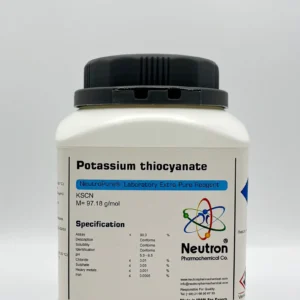Cyclohexanone
| Formula | C6H10O |
| Chemical formula | C6H10O |
| Density | 0.95 g/cm3 (20°C) |
| Molar mass | 98.15 g/mol |
| CAS number | 108-94-1 |
| HS Code | 29142200 |
| EC number | 203-631-1 |
| Storage | at +15 to +25 °C |
| SDS | available |
| R phrase | R 10-20 |
| S phrase | S 25 |
| Odour | pungent |
| Form | liquid |
| Color | colourless |
| Explosion limit | 1.3 – 9.4 Vol % |
| Ignition temprature | 430 °C |
| p H value | ~7 (70 g/l 20°C) |
| Solubility in water | 90 g/l (20°C) |
| Solubility in ethanol | soluble |
| Refractive index | 1.4507(20°C) |
| Flash point | 43 °C |
| Boiling point | ~155°C |
| Melting point | -31°C |
| Vapour pressure | ~4.5 hPa |
| Viscosity dynamical | 2.2 mPa*s |
| Viscosity kinematic | 0.75 mm2*s |
| Saturation concentration | 19 g/m3 |
| Assay | ≥ | 99 | % |
| Description | Conforms | ||
| Identification | Conforms | ||
| Solubility | Conforms | ||
| Density (d 20 °C/4 °C) | 0.946 – 0.948 | ||
| Water | ≤ | 0.2 | % |
Cyclohexanone is a colorless to pale yellow liquid with a characteristic sweet and camphor-like odor, widely used as an important solvent and intermediate in organic synthesis. It serves as a key building block for the production of nylon and other synthetic fibers.
🏭⚗️ Production
Cyclohexanone is primarily produced industrially by the oxidation of cyclohexane in the presence of air and catalysts, such as cobalt or manganese salts. Another common method is the dehydrogenation of cyclohexanol. These processes yield cyclohexanone with high purity for use in various chemical syntheses and industrial applications.
🔬 Properties
The chemical formula of cyclohexanone is C₆H₁₀O, and its molar mass is approximately 98.15 g/mol. It appears as a clear, colorless to pale yellow liquid with a boiling point around 156 °C and a melting point near −31 °C. Cyclohexanone is moderately soluble in water but miscible with most organic solvents such as alcohols, ethers, and hydrocarbons. It is a ketone with a reactive carbonyl group, making it useful for various chemical reactions including nucleophilic addition and condensation.
🧪 Applications
Cyclohexanone is extensively used as a solvent in paints, varnishes, adhesives, and coatings. It is also a critical intermediate in the production of adipic acid and caprolactam, which are precursors for nylon-6 fibers and plastics. Furthermore, cyclohexanone finds application in the manufacture of pharmaceuticals, agrochemicals, and fragrances. In laboratories, it is frequently employed as a reagent or solvent in organic synthesis.
⚠️ Safety
Cyclohexanone should be handled with care as it is a flammable liquid that can cause irritation to the skin, eyes, and respiratory tract. Prolonged exposure to vapors may cause dizziness and headaches. It is recommended to use personal protective equipment such as gloves, safety goggles, and work in a well-ventilated area or fume hood. Cyclohexanone should be stored in tightly closed containers, away from heat, sparks, and incompatible substances like strong oxidizers and acids.





